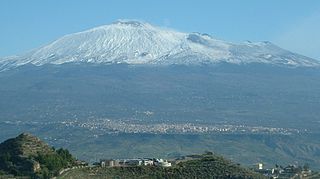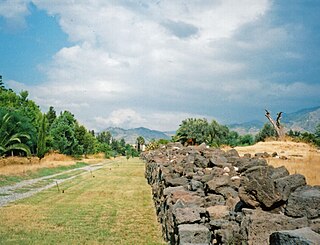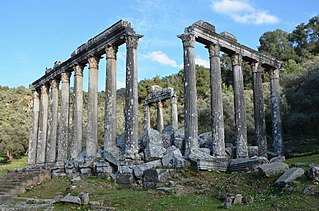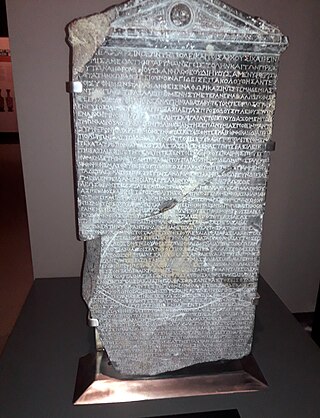
Heracleopolis Magna, Heracleopolis or Herakleoupolis (Ἡρακλεούπολις) is the Roman name of the capital of the 20th nome of ancient Upper Egypt, known in Ancient Egyptian as nn nswt. The site is located approximately 15 km (9.3 mi) west of the modern city of Beni Suef, in the Beni Suef Governorate of Egypt.
Adranus or Adranos was a fire god worshipped by the Sicels, an ancient population of the island of Sicily. His worship occurred all over the island, but particularly in the town of Adranus, modern Adrano, near Mount Etna. According to Aelian, about a thousand sacred dogs were kept near his temple in this town.

Phanagoria was the largest ancient Greek city on the Taman peninsula, spread over two plateaus along the eastern shore of the Cimmerian Bosporus.

Morgantina is an archaeological site in east central Sicily, southern Italy. It is sixty kilometres from the coast of the Ionian Sea, in the province of Enna. The closest modern town is Aidone, two kilometres southwest of the site. The site consists of a two-kilometre-long ridge running southwest-northeast, known as Serra Orlando, and a neighbouring hill at the northeast called Cittadella. Morgantina was inhabited in several periods. The earliest major settlement was made at Cittadella and lasted from about 1000/900 to about 450 BCE. The other major settlement was located on Serra Orlando, and existed from about 450 BCE to about 50 CE in Magna Graecia. Morgantina has been the subject of archaeological investigation since the early 20th century.

Motya was an ancient and powerful city on San Pantaleo Island off the west coast of Sicily, in the Stagnone Lagoon between Drepanum and Lilybaeum. It is within the present-day commune of Marsala, Italy.

Adrano, ancient Adranon, is a town and comune in the Metropolitan City of Catania on the east coast of Sicily.
Dionysupolis or Dionysoupolis or Dionysopolis or Dionysou polis was a town of ancient Thrace, later of Moesia, on the river Ziras. It was founded as a Thracian settlement in was founded in the 5th century BC, but was later colonised by the Ionian ancient Greeks and given the name Cruni or Krounoi (Κρουνοί). It was named Krounoi from the nearby founts of water. It was renamed as Dionysopolis after the discovery of a statue of Dionysus in the sea. Later it became a Greek-Byzantine and Bulgarian fortress. The town also bore the name Matiopolis.

Paternò is a comune (municipality) in the Metropolitan City of Catania, in the Italian region of Sicily. With a population (2016) of 48,009, it is the third municipality of the province after Catania and Acireale.

Agira is a town and comune in the province of Enna, Sicily. It is located in the mid-valley of the River Salso, 35 kilometres from Enna. Until 1861 it was called San Filippo d'Argiriò, in honour of its saint Philip of Agira.

Naxos or Naxus was an ancient Greek city of Magna Graecia, presently situated in modern Giardini Naxos near Taormina on the east coast of Sicily.

Gortyna was a town of ancient Crete which appears in the Homeric poems under the form of Γορτύν; but afterwards became usually Gortyna (Γόρτυνα). According to Stephanus of Byzantium it was originally called Larissa (Λάρισσα) and Cremnia or Kremnia (Κρήμνια).

Alinda was an inland city and bishopric in ancient Caria, in Asia Minor (Anatolia). Modern scholars identify Alinda with the Hellenistic foundation of Alexandria ad Latmum noted by Stephanus of Byzantium.

Euromus or Euromos – also, Europus or Europos (Εὐρωπός), Eunomus or Eunomos (Εὔνωμος), Philippi or Philippoi (Φίλιπποι); earlier Kyromus and Hyromus – was an ancient city in Caria, Anatolia; the ruins are approximately 4 km southeast of Selimiye and 12 km northwest of Milas, Muğla Province, Turkey. It was situated at the foot of Mount Grium, which runs parallel to Mount Latmus, and was built by one Euromus, a son of Idris, a Carian.

Corinth was a city-state (polis) on the Isthmus of Corinth, the narrow stretch of land that joins the Peloponnese peninsula to the mainland of Greece, roughly halfway between Athens and Sparta. The modern city of Corinth is located approximately 5 kilometres (3.1 mi) northeast of the ancient ruins. Since 1896, systematic archaeological investigations of the Corinth Excavations by the American School of Classical Studies at Athens have revealed large parts of the ancient city, and recent excavations conducted by the Greek Ministry of Culture have brought to light important new facets of antiquity.

Nikōnion and Nikōnia was an ancient Greek city on the east bank of the Dniester estuary. Its ruins are located 300 meters to the northwest of the modern village Roksolany, in the Odesa Raion of the Odesa Oblast, Ukraine.

Gryneium or Gryneum or Gryneion, also Grynium or Grynion (Γρύνιον), Grynia or Gryneia (Γρύνεια) and Grynoi (Γρῦνοι), was a city of ancient Aeolis. It was located 40 stadia from Myrina and 70 from Elaea. In early times it was independent, one of the 12 important cities of Aeolis, but afterwards became subject to Myrina. It contained a sanctuary of Apollo with an ancient oracle and a splendid temple of white marble. Because of the city Apollo derived the surname of Gryneus. Pausanias wrote that at Gryneium, where there was an amazing grove of Apollo, with cultivated trees, and all those which, although they bear no fruit, are pleasing to smell or look upon.

Nagidos was an ancient city of Cilicia. In ancient times it was located between Anemurion to the west and Arsinoe to the east. Today its ruins are found on the hill named Paşabeleni at the mouth of the Sini Cay near Bozyazı in Mersin Province, Turkey. It lies at a distance of ca. 20 km to the east of Anamur. Like its eastern neighbor Kelenderis, it was a colony of Samos. The small island of Nagidoussa is opposite Nagidos; on it are the ruins of an Ottoman fortress.
Omphace or Omphake was an ancient Sicanian town in the Greek territory of Gela, and is one of very few cities we know from literary sources to have been in this territory.
Argura, called Argissa (Ἄργισσα) in Homer's Iliad, was a town and polis (city-state) in Pelasgiotis in ancient Thessaly, on the Peneus, and near Larissa. The name of the town was also given as Argusa (Ἆργουσσα) in some ancient sources. The distance between this place and Larissa is so small as to explain the remark of the Scholiast on Apollonius of Rhodes, that the Argissa of Homer was the same as Larissa. The editors of the Barrington Atlas of the Greek and Roman World and The Princeton Encyclopedia of Classical Sites identify the site of Agura with a place called Gremnos Magoula, approximately 7 kilometres (4.3 mi) west of Larissa, which has a nearby tumulus.

Pygela or Phygela (Φύγελα) was a small town of ancient Ionia, on the coast of the Caystrian Bay, a little to the south of Ephesus. It is located near Kuşadası, Asiatic Turkey. The ruins are right down on Pygela Plaji, "Pygela Beach." They are obviously partly drowned.

















